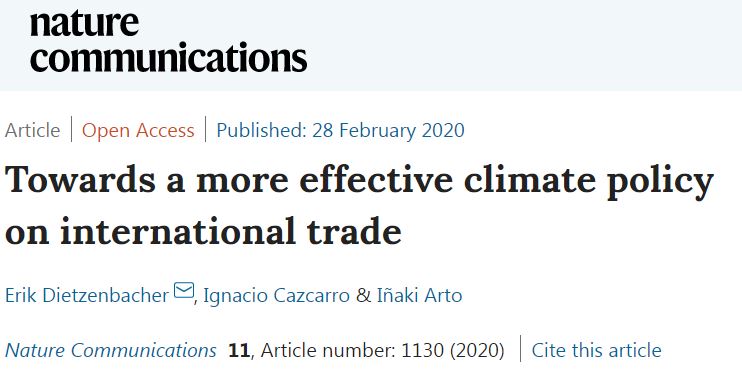NEW BC3 publication in Nature Communications journal “Towards a more effective climate policy on international trade”

Dietzenbacher, E. Cazcarro, C., Arto, I. 2020.
Towards a more effective climate policy on international trade.
Nature Communications. 11. 1130. DOI (10.1038/s41467-020-14837-5).
[altmetric doi="10.1038/s41467-020-14837-5" float" float="right" popover="left"]
The attribution of the responsibility for the emissions for CO2 between producers and consumers is a controversial issue in NEW BC3 publication in Nature Communications journal “Towards a more effective climate policy on international trade” climate change policy and research. Two main accounting methods are used in the literature to determine countries’ contribution to global emissions. The production-based accounting (PBA) measures the amount of CO2 released to the atmosphere by the industries and households of a country. The consumption-based accounting (CBA) attributes emissions to the country’s consumption of final products. CBA redistributes the emissions from PBA and considers that emissions in another country are necessary for the home country’s consumption. These two accounting frameworks are used to assign responsibility for current CO2 emissions. Producer responsibility addresses the countries that directly generate the emissions. Consumer responsibility addresses the countries that ultimately drive the pressure.
On the other hand, it has been argued that an accounting framework for attributing responsibilities should credit actions contributing to reduce global emissions and should penalize actions increasing them. However, neither PBA nor CBA satisfy this principle. In this study the authors develop a novel method to allocate responsibilities for CO2 emissions and propose a scheme for assigning credits and penalties depending on how countries contribute to reduce or increase global emissions. This leads to the emission responsibility allotment (ERA) for assigning responsibilities. The study also illustrates the differences between ERA and PBA and CBA by comparing their results for 41 countries and regions.
The ERA can be a powerful tool to track and assess how countries reduce global emissions through changing their production, consumption or trade patterns. Several voices stressed the relevance of having key indicators to track the progress of individual and collective contributions in the context of the Paris Agreement. ERA can serve to track joint actions comprehensively and over time. This information can be useful in periodical global stocktaking. Main sources of information to evaluate this progress are the national emissions inventories, which follow PBA. However, as indicated in the COP21, any comprehensive assessment should look into the global effects of reductions of emissions, which is what the ERA does.
